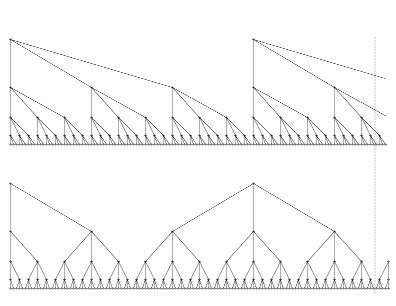The original contents of this post were used as a draft for that now has its own page on this site. I’m keeping this post here to allow comments and discussion by others.
In brief, ternary (base 3) numbers are usually expressed using digits 0, 1 and 2. Balanced ternary uses digits with values -1, 0 and +1 instead. Here are diagrams representing the “standard” and balanced versions of base 3. Each step lower in a diagram represents adding one more digit of precision to a number. In the upper diagram, all numbers that begin with “0.1…” are equal to or larger than 0.1. In the lower diagram, the value 0.1 is the precise middle of all numbers that begin with “0.1…”.
The decimal number system we use looks more like the upper diagram, but with ten divisions at each level rather than three.
(0,1) – binary,
(0,1,2) – base 3,
(0,1,2,3,4) – base 5,
(0,1,2,3,4,5,6,7) – base 8 – octal,
(0,1,2,3,4,5,6,7,8,9) – base ten,
(0,1,2,3,4,5,6,7,8,9,A,B,C,D,E,F) – base sixteen – hexadecimal, etc.
Only with odd-numbered bases can one use the lower form fully in balance (a true zero with balanced + and – with each digit of significance). If we tried to use the bottom pattern with base ten, for instance, including zero near the middle, we’d need to use -4 to +5, -5 to +4, or some other unbalanced pattern.

- Diagram, two forms of Base 3
In the first form, the descending lines from a single point represent the digits 0, 1, or 2. In the second form, the descending lines represent the digits -1 (to the left), 0 (vertical), or 1 (to the right).
Abhijit Bhattacharjee of India is one of those commenting on this post. He once had a site with many historical references to the description or use of base 3. I found copies of Abhijit’s materials in archives – the page Finding old Web Pages suggests a number of ways of finding archived web information. Info on the tool I used can be found at the Web Archiving at archive.org site.


Abhijit
Thanks, Sigurd,
Got your mail, where are you and where have you been.
Abhijit
sigurd
I moved to Vermont’s “Northeast Kingdom” (decades ago) -I’d already moved, I believe, when we exchanged messages some years ago.
Are you doing anything more/new these days in your “balanced base 3” explorations?
Abhijit
Dear Sigurd,
I lost all that content on tristate a couple of years ago. The site is also no longer up.
Do you have the content cached somewhere, particularly the bibliography.
Thanks,
Abhijit
sigurd
What a loss that would be! I googled [web “wayback machine”] and tried web.archive.org for your tristate and biblio pages – and got BOTH! – revised posting has links that worked for me. I’ll send you a separate email with the text and links captured from the archived copy of your biblio page.
Sigurd
Thomas H. Morse
The website summarizes a division algorithm I developed for balanced
base division.
sigurd
Thomas,
Your web site link (to http://balancedbases.info/) is not obvious – it’s a link associated with your name in your comment. I’ll have a look at your division algorithm.